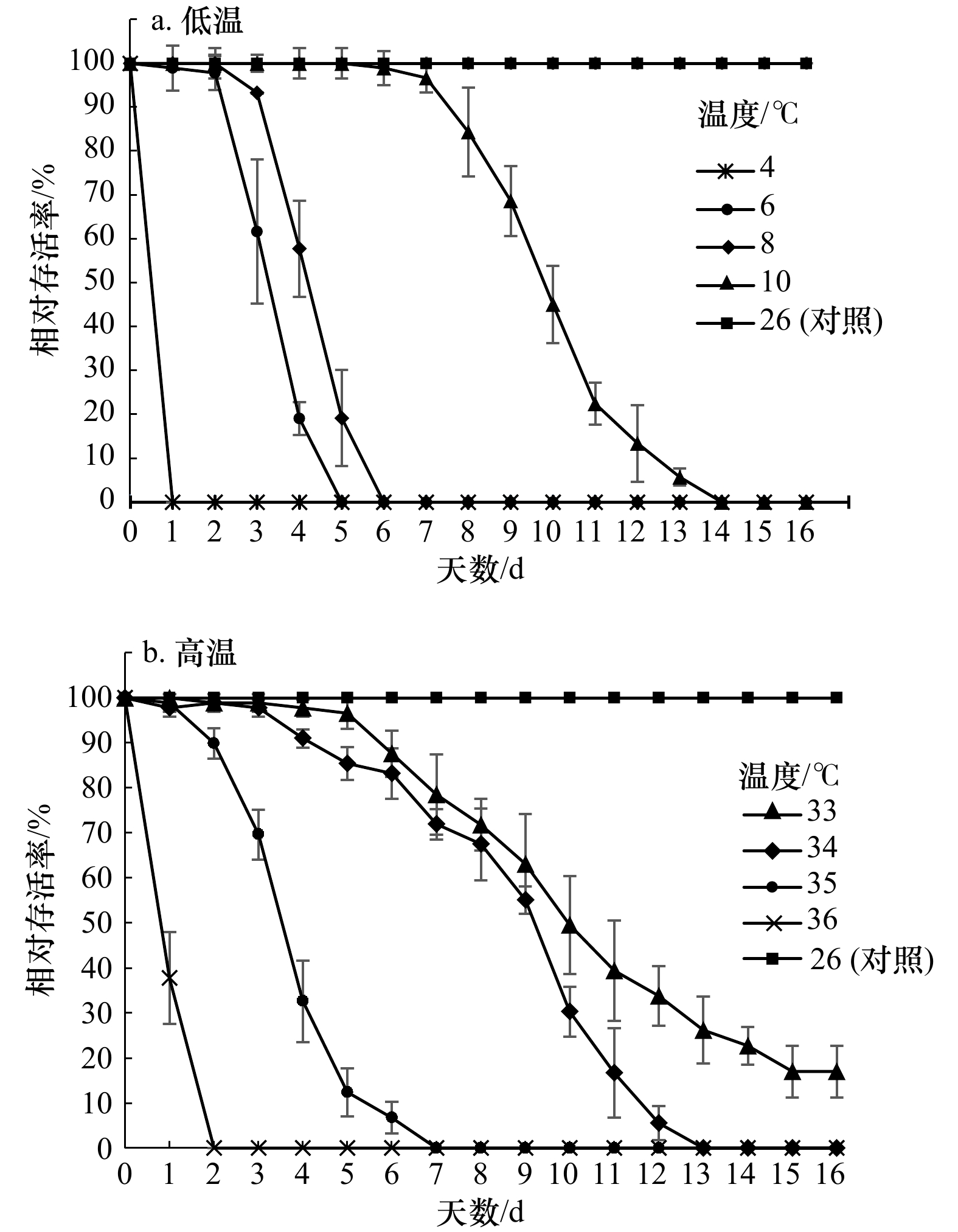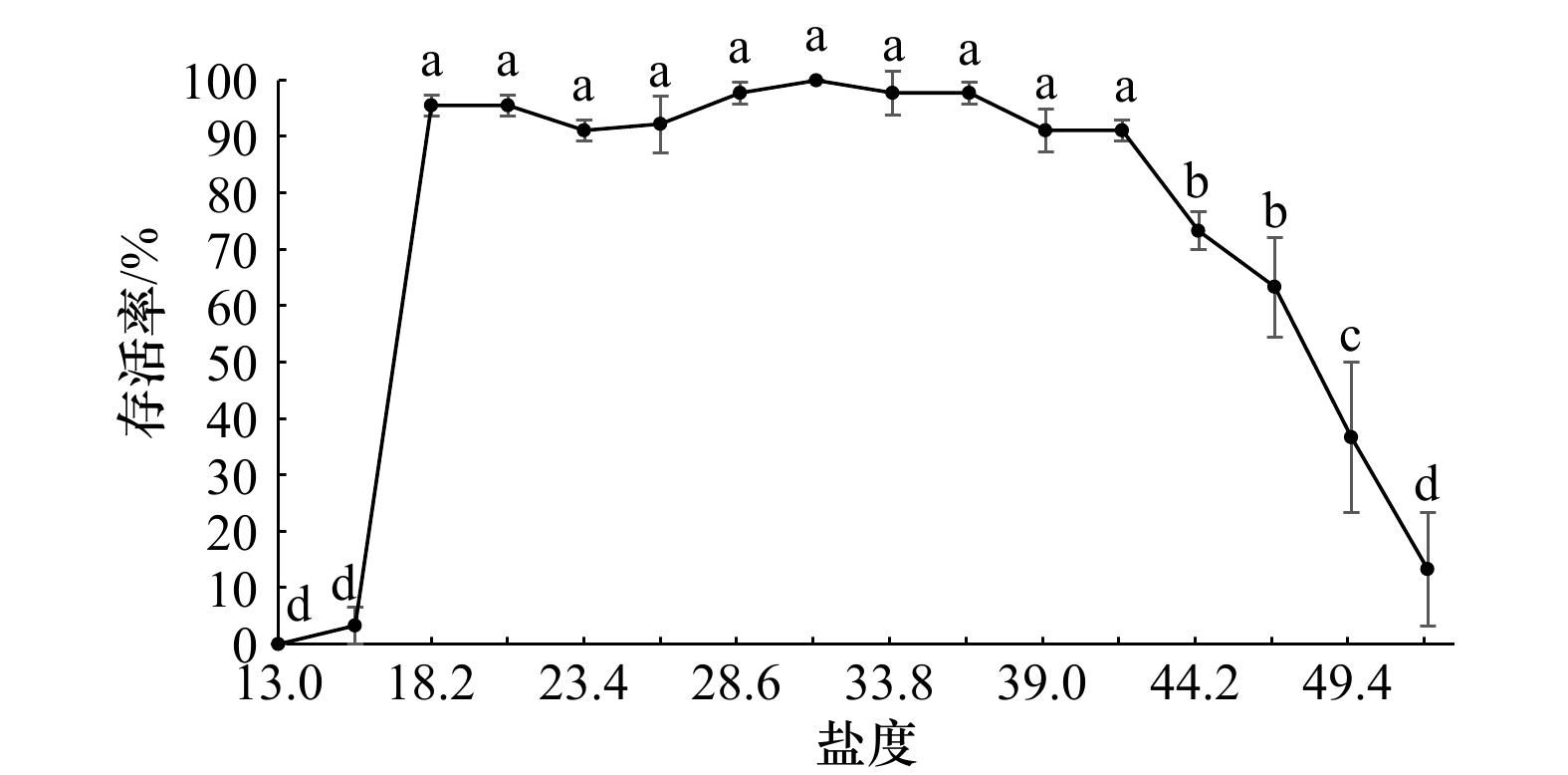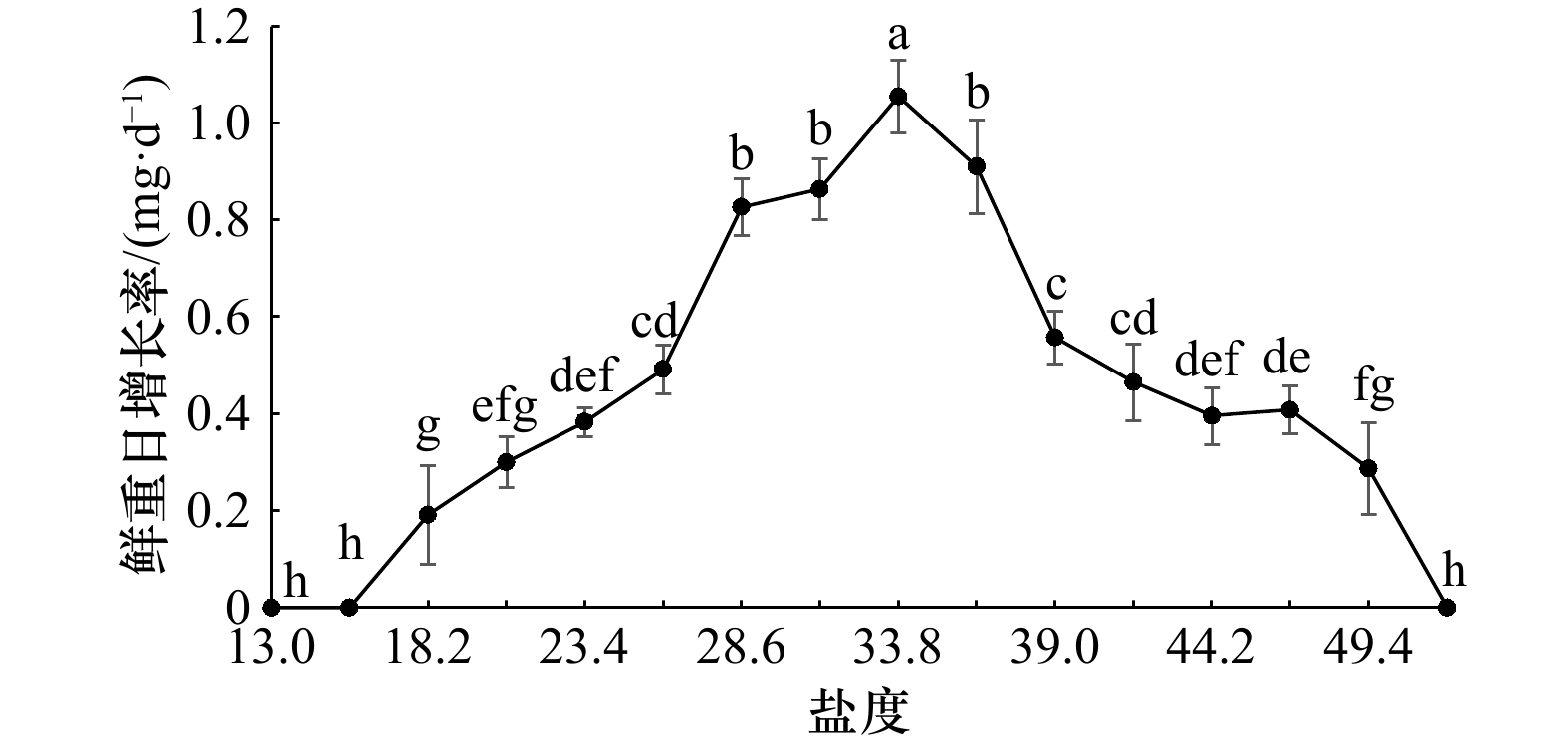Study on temperature and salinity tolerance of Tapes dorsatus juveniles
-
摘要: 本实验在室内控制条件下,采用实验生态学方法研究了钝缀锦蛤(Tapes dorsatus)稚贝对温度和盐度的耐受性。在温度耐受性方面:(1)稚贝在低温端温度为4℃、6℃、8℃、10℃时保持90%~100%存活的时间分别为0 d、2 d、3 d、7 d;在高温端温度为33℃、34℃、35℃、36℃时保持90%~100%存活率的时间分别为5 d、4 d、1 d、0 d;(2)在温度胁迫条件下,钝缀锦蛤在48 h、96 h、144 h和192 h的半致死温度在低温端分别为5.02℃、7.68℃、9.01℃和9.20℃;高温端分别为35.44℃、34.74℃、34.43℃和34.25℃。在盐度耐受性方面:(1)在低盐端盐度为13.0、15.6、18.2、20.8、23.4时保持90%~100%存活率的时间分别为1 d、1 d、≥9 d、≥9 d、≥9 d;在高盐端盐度为41.6、44.2、46.8、49.4、52.0时保持90%~100%存活率的时间分别为9 d、2 d、1 d、1 d、1 d;(2)钝缀锦蛤稚贝在48 h、96 h、144 h和192 h的半致死盐度,低盐端分别为14.46、16.02、16.76、16.91;高盐端分别为>52.0、51.79、50.58、48.88;(3)存活的适宜盐度为16.91~48.20,最适盐度为18.20~41.60;生长的适宜盐度为23.58~45.15,最适盐度为33.90。本实验结果表明,钝缀锦蛤稚贝对高温的耐受性较强,适合在南方温度较高的海域养殖;其适宜生存盐度范围较广,最适生长盐度与外海海水盐度基本相同,适合外海养殖。Abstract: In order to investigate the tolerance of temperature and salinity of Tapes dorsatus juveniles, ecological methods with the laboratory controlled system was used in this study. The results showed that: (1) in the temperature tolerance test, juveniles maintained 90%−100% survival rate at the low-temperature groups (4℃, 6℃, 8℃ and 10℃) for 0 d, 2 d, 3 d and 7 d and at the high-temperature groups (33℃, 34℃, 35℃ and 36℃) for 5 d, 4 d, 1 d and 0 d, respectively; (2) under temperature stress, at the low-temperature groups, the semilethal temperatures at 48 h, 96 h, 144 h and 192 h were 5.02℃, 7.68℃, 9.01℃ and 9.20℃. And in the high-temperature groups, the semilethal temperatures at 48 h, 96 h, 144 h and 192 h were 35.44℃, 34.74℃, 34.43℃ and 34.25℃, respectively. In the salinity tolerance test, (1) juveniles maintained 90%−100% survival rate at low-salinity groups (13.0, 15.6, 18.2, 20.8 and 23.4) for 1 d, 1 d, ≥9 d, ≥9 d and ≥9 d while in the high-salinity groups (41.6, 44.2, 46.8, 49.4 and 52.0) followed by 9 d, 2 d, 1 d, 1 d and 1 d, respectively; (2) the semilethal salinity at 48 h, 96 h, 144 h and 192 h in the low-salinity groups were 14.46, 16.02, 16.76 and 16.91, while in the high-salinity groups were >52.0, 51.79, 50.58 and 48.88, respectively; (3) for survival, the suitable and the optimum salinities of T. dorsatus juveniles were 16.91−48.20 and 18.20−41.60, respectively. For growth, the suitable and the optimum salinities were 23.58−45.15 and 33.90, respectively. The results indicated that T. dorsatus juveniles had strong tolerance to high temperature and were suitable for cultivation with higher temperatures in the southern sea area. The suitable survival salinity range was wide, and the optimal growth salinity was basically the same as the offshore sea water. T. dorsatus juveniles suitable for breeding in the offshore sea water.
-
Key words:
- Tapes dorsatus /
- juveniles /
- temperature /
- salinity /
- tolerance
-
表 1 钝缀锦蛤稚贝在不同温度48 h、96 h、144 h和192 h下的相对存活率
Tab. 1 Relative survival rate of Tapes dorsatus juveniles at different temperatures for 48 h, 96 h, 144 h and 192 h
温度/℃ 相对存活率/% 48 h 96 h 144 h 192 h 4 0±0c 0±0c 0±0c 0±0d 6 97.78±3.85a 19.08±3.69bc 0±0c 0±0d 8 98.89±1.92a 57.76±6.34b 0±0c 0±0d 10 100.00±0a 98.89±1.92a 97.78±1.92a 84.37±5.82b 26(对照) 100.00±0a 100.00±0a 100.00±0a 100.00±0a 33 98.89±1.92a 97.74±1.96a 87.6±25.15b 71.84±5.72bc 34 98.89±1.92a 91.00±2.03a 83.2±25.58b 67.51±7.96c 35 89.89±3.34b 32.68±9.04b 6.78±3.51C 0±0d 36 0±0c 0±0c 0±0c 0±0d 注:上标不同小写字母表示各组之间差异显著(p<0.05)。 表 2 钝缀锦蛤稚贝在不同盐度48 h、96 h、144 h和192 h下的相对存活率
Tab. 2 Relative survival rate of juveniles Tapes dorsatus at different salinities for 48 h, 96 h, 144 h and 192 h
盐度 相对存活率/% 48 h 96 h 144 h 192 h 13.0 10.00±8.82d 0±0e 0±0e 0±0e 15.6 82.22±10.72c 40.00±8.82d 12.22±3.85e 3.33±1.92e 18.2 98.89±1.92a 97.78±1.92a 96.67±3.33a 95.56±1.96a 20.8 98.89±1.92a 97.78±1.92a 97.78±1.92a 96.67±0a 23.4 98.89±1.92a 96.67±3.34ab 95.56±1.92a 94.44±1.92a 26.0 100.00±0a 98.89±1.92a 98.89±1.92a 96.67±3.33a 28.6 100.00±0a 100.00±0a 98.89±1.92a 97.78±1.92a 31.2 100.00±0a 100.00±0a 100.00±0a 100.00±0a 32.6(对照) 100.00±0a 100.00±0a 100.00±0a 100.00±0a 33.8 100.00±0a 98.89±1.92a 98.89±1.92a 97.78±3.85a 36.4 98.89±1.92a 97.78±1.92a 97.78±1.92a 97.78±1.92a 39.0 96.67±0ab 94.44±1.93ab 92.22±1.92ab 92.22±1.92a 41.6 100.00±0a 100.00±0a 96.67±0a 91.11±1.92a 44.2 92.22±3.85abc 80.00±3.33b 80.00±3.33b 76.67±0b 46.8 83.33±3.34c 66.67±10.00c 65.56±8.38c 64.44±10.18b 49.4 85.56±5.09bc 62.22±10.72c 54.44±8.39c 45.56±6.94c 52.0 83.33±3.34c 42.22±6.94d 37.78±10.72d 17.78±8.39d 注:上标不同小写字母表示各组之间差异显著(p<0.05)。 -
[1] 中国科学院中国动物志编辑委员会. 中国动物志[M]. 北京: 科学出版社, 2001.Editorial Committee of Zoology of China, Chinese Academy of Sciences. Fauna Sinica[M]. Beijing: Science Press, 2001. [2] 黄洋, 杜涛, 杨世平. 钝缀锦蛤生态习性的初步研究[J]. 水产科学, 2008, 27(4): 175−178. doi: 10.3969/j.issn.1003-1111.2008.04.004Huang Yang, Du Tao, Yang Shiping. Preliminary studies on ecological habit of Tapes dorsatus[J]. Fisheries Science, 2008, 27(4): 175−178. doi: 10.3969/j.issn.1003-1111.2008.04.004 [3] 巫旗生, 曾志南, 宁岳, 等. 钝缀锦蛤形态性状对活体质量的影响[J]. 水产科学, 2018, 37(1): 110−114.Wu Qisheng, Zeng Zhinan, Ning Yue, et al. Effects of shell morphological traits on live body weight of Clam Tapes conspersus[J]. Fisheries Science, 2018, 37(1): 110−114. [4] 杨家林, 邹杰, 彭慧婧. 温度、盐度和体质量对钝缀锦蛤滤食率和同化率的影响[J]. 水产科学, 2019, 38(1): 104−108.Yang Jialin, Zou Jie, Peng Huijing. Effects of temperature, salinity and body weight on filtration and assimilation rates of clam Tapes dorsatus[J]. Fisheries Science, 2019, 38(1): 104−108. [5] 巫旗生, 文宇, 曾志南, 等. 钝缀锦蛤繁殖周期和胚胎发育[J]. 中国水产科学, 2017, 24(3): 488−496. doi: 10.3724/SP.J.1118.2017.16280Wu Qisheng, Wen Yu, Zeng Zhinan, et al. The reproductive cycle and embryonic development of the bivalve mollusk Tapes conspersus[J]. Journal of Fishery Sciences of China, 2017, 24(3): 488−496. doi: 10.3724/SP.J.1118.2017.16280 [6] 聂振平, 彭慧婧, 邹杰, 等. 钝缀锦蛤选育群体F2生长性状相关性及遗传力分析[J]. 广西科学, 2020, 27(3): 241−247.Nie Zhenping, Peng Huijing, Zou Jie, et al. Correlation and heritability analysis on growth traits for F2 population of Tapes dorsatus[J]. Guangxi Sciences, 2020, 27(3): 241−247. [7] 陈军, 李琪, 孔令锋, 等. 基于COI序列的DNA条形码在中国沿海缀锦蛤亚科贝类中的应用分析[J]. 动物学研究, 2010, 31(4): 345−352.Chen Jun, Li Qi, Kong Lingfeng, et al. COI-based DNA barcoding in Tapetinae species (Mollusca, Bivalvia, Veneridae) along the coast of China[J]. Zoological Research, 2010, 31(4): 345−352. [8] 潘鹤婷, 袁媛, 吴琪, 等. 缀锦蛤亚科(Tapetinae)贝类线粒体DNA序列的系统学分析[J]. 海洋与湖沼, 2008, 39(3): 284−290. doi: 10.3321/j.issn:0029-814X.2008.03.015Pan Heting, Yuan Yuan, Wu Qi, et al. Molecular phylogeny of Tapetinae (Mollusca, Bivalvia) based on mtDNA sequence[J]. Oceanologia et Limnologia Sinica, 2008, 39(3): 284−290. doi: 10.3321/j.issn:0029-814X.2008.03.015 [9] 程汉良, 周旻纯, 陈冬勤, 等. 基于16S rDNA序列的帘蛤科贝类分子系统发育研究[J]. 水产科学, 2012, 31(11): 657−662. doi: 10.3969/j.issn.1003-1111.2012.11.005Cheng Hanliang, Zhou Minchun, Chen Dongqin, et al. Phylogenetic analysis of Veneridae (Mollusca: Bivalvia) based on mitochondrial 16S rDNA[J]. Fisheries Science, 2012, 31(11): 657−662. doi: 10.3969/j.issn.1003-1111.2012.11.005 [10] Nell J A, O’Connor W A, Hand R E, et al. Hatchery production of diploid and triploid clams, Tapes dorsatus (Lamarck 1818): a potential new species for aquaculture[J]. Aquaculture, 1995, 130(4): 389−394. doi: 10.1016/0044-8486(95)92761-Q [11] Nell J A, Paterson K J. Salinity studies on the clams Katelysia rhytiphora (Lamy) and Tapes dorsatus (Lamarck)[J]. Aquaculture Research, 1997, 28(2): 115−119. doi: 10.1111/j.1365-2109.1997.tb01023.x [12] 文宇. 钝缀锦蛤繁殖生物学及稚贝生长的研究[D]. 长沙: 湖南农业大学, 2015.Wen Yu. Research on reproductive biology and the growth of shellfish larvae of Tapes dorsal[D]. Changsha: Hunan Agricultural University, 2015. [13] 刘志刚, 王辉, 栗志民, 等. 墨西哥湾扇贝高起始致死温度的研究[J]. 中国水产科学, 2007, 14(5): 778−785. doi: 10.3321/j.issn:1005-8737.2007.05.011Liu Zhigang, Wang Hui, Li Zhimin, et al. Upper incipient lethal temperature of Argopecten irradians concentricus Say[J]. Journal of Fishery Sciences of China, 2007, 14(5): 778−785. doi: 10.3321/j.issn:1005-8737.2007.05.011 [14] 刘志刚, 刘建勇, 王辉, 等. 墨西哥湾扇贝稚贝盐度适应性的研究[J]. 湛江海洋大学学报, 2006, 26(6): 12−16.Liu Zhigang, Liu Jianyong, Wang Hui, et al. Study on adaptability of juveniles of Argopecten irradians concentricus Say to salinity[J]. Journal of Zhanjiang Ocean University, 2006, 26(6): 12−16. [15] 谭杰, 白成, 李燕, 等. 印尼大珠母贝稚贝对温度、盐度的耐受性[J]. 广东海洋大学学报, 2017, 37(3): 110−116. doi: 10.3969/j.issn.1673-9159.2017.03.017Tan Jie, Bai Cheng, Li Yan, et al. Tolerance of Indonesia Pinctada maxima juveniles on temperature and salinity[J]. Journal of Guangdong Ocean University, 2017, 37(3): 110−116. doi: 10.3969/j.issn.1673-9159.2017.03.017 [16] 杨晓新, 林小涛, 计新丽, 等. 温度、盐度和光照条件对翡翠贻贝滤水率的影响[J]. 海洋科学, 2000, 24(6): 36−39. doi: 10.3969/j.issn.1000-3096.2000.06.011Yang Xiaoxin, Lin Xiaotao, Ji Xinli, et al. The effects of light intensity, temperature and salinity on the filtration rate of Perna viridis[J]. Marine Sciences, 2000, 24(6): 36−39. doi: 10.3969/j.issn.1000-3096.2000.06.011 [17] Bayne B L. The physiology of suspension feeding by bivalve molluscs: an introduction to the Plymouth “TROPHEE” workshop[J]. Journal of Experimental Marine Biology and Ecology, 1998, 219(1/2): 1−19. [18] Davenport J, Fletcher J S. The effects of simulated estuarine mantle cavity conditions upon the activity of the frontal gill cilia of Mytilus edulis[J]. Journal of the Marine Biological Association of the United Kingdom, 1978, 58(3): 671−681. doi: 10.1017/S002531540004131X [19] 张媛, 方建光, 毛玉泽, 等. 水温、盐度和饵料密度对橄榄蚶滤水率的影响[J]. 海洋科学, 2015, 39(9): 39−43. doi: 10.11759/hykx20140414002Zhang Yuan, Fang Jianguang, Mao Yuze, et al. Effects of water temperature, salinity and diet concentration on the filtration rate of Estellarca olivacea[J]. Marine Sciences, 2015, 39(9): 39−43. doi: 10.11759/hykx20140414002 [20] 冀德伟, 陈琛, 李婷婷, 等. 盐度胁迫对泥蚶能量代谢的影响[J]. 水产科学, 2016, 35(5): 504−509.Ji Dewei, Chen Chen, Li Tingting, et al. Influences of salinity stress on energy metabolism in blood clam Tegillarca granosa[J]. Fisheries Science, 2016, 35(5): 504−509. [21] 姜北, 董颖, 高杉, 等. 大竹蛏幼贝滤水率的响应面法分析[J]. 水产科学, 2016, 35(4): 313−320.Jiang Bei, Dong Ying, Gao Shan, et al. Optimization of filtration rate in juvenile razor clam Solen grandis by response surface methodology[J]. Fisheries Science, 2016, 35(4): 313−320. [22] Tettelbach S T, Rhodes E W. Combined effects of temperature and salinity on embryos and larvae of the northern bay scallop Argopecten irradians irradians[J]. Marine Biology, 1981, 63(3): 249−256. doi: 10.1007/BF00395994 [23] Calabrese A. Individual and combined effects of salinity and temperature on embryos and larvae of the coot clam, Mulinia lateralis (Say)[J]. The Biological Bulletin, 1969, 137(3): 417−428. doi: 10.2307/1540164 [24] 栗志民, 刘志刚, 姚茹, 等. 温度和盐度对皱肋文蛤幼贝存活与生长的影响[J]. 生态学报, 2010, 30(13): 3406−3413.Li Zhimin, Liu Zhigang, Yao Ru, et al. Effect of temperature and salinity on the survival and growth of Meretrix lyrata juveniles[J]. Acta Ecologica Sinica, 2010, 30(13): 3406−3413. [25] Coleman S, Cleaver C, Morse D, et al. The coupled effects of stocking density and temperature on Sea Scallop (Placopecten magellanicus) growth in suspended culture[J]. Aquaculture Reports, 2021, 20: 100684. doi: 10.1016/j.aqrep.2021.100684 [26] 栗志民, 刘志刚, 邓海东. 温度和盐度对企鹅珍珠贝清滤率、滤食率、吸收率的影响[J]. 水产学报, 2011, 35(1): 96−103.Li Zhimin, Liu Zhigang, Deng Haidong. Effects of temperature and salinity on clearance rate, filtration rate and absorption efficiency of Pteria penguin[J]. Journal of Fisheries of China, 2011, 35(1): 96−103. [27] 曹善茂, 梁伟锋, 汪健, 等. 岩扇贝幼贝滤食率的基础研究[J]. 大连海洋大学学报, 2016, 31(6): 612−617.Cao Shanmao, Liang Weifeng, Wang Jian, et al. Fundamental research on filter-feeding rate of juvenile rock scallop[J]. Journal of Dalian Ocean University, 2016, 31(6): 612−617. [28] 范嗣刚, 黄桂菊, 刘宝锁, 等. 盐度与温度对大珠母贝和合浦珠母贝滤水率及摄食率的影响[J]. 水生态学杂志, 2014, 35(3): 61−65. doi: 10.3969/j.issn.1674-3075.2014.03.010Fan Sigang, Huang Guiju, Liu Baosuo, et al. Effects of salinity and temperature on the filtration rate and ingestion rate of Pinctada maxima and Pinctada fucata[J]. Journal of Hydroecology, 2014, 35(3): 61−65. doi: 10.3969/j.issn.1674-3075.2014.03.010 [29] 袁有宪, 曲克明, 陈聚法, 等. 栉孔扇贝对环境变化适应性研究—温度对存活、呼吸、摄食及消化的影响[J]. 中国水产科学, 2000, 7(3): 24−27. doi: 10.3321/j.issn:1005-8737.2000.03.006Yuan Youxian, Qu Keming, Chen Jufa, et al. Adaptability of Chlymys farreri to environment—Effects of temperature on survival, respiration, ingestion and digestion[J]. Journal of Fishery Sciences of China, 2000, 7(3): 24−27. doi: 10.3321/j.issn:1005-8737.2000.03.006 [30] 刘甜雨, 王清, 陈慕雁. 热刺激对栉孔扇贝免疫功能和热休克蛋白表达的影响[J]. 中国海洋大学学报(自然科学版), 2017, 47(8): 31−43.Liu Tianyu, Wang Qing, Chen Muyan. Effect of thermal stimulus on immune function and heat shock protein expression of scallop Chlamys farreri[J]. Periodical of Ocean University of China, 2017, 47(8): 31−43. [31] 刘慧慧, 李云娟, 何建瑜, 等. 热休克及菌胁迫对厚壳贻贝HSP70基因表达的影响[J]. 水产学报, 2015, 39(7): 971−977.Liu Huihui, Li Yunjuan, He Jianyu, et al. Expression of HSP70 in Mytilus coruscus under stress of thermal shock and bacteria[J]. Journal of Fisheries of China, 2015, 39(7): 971−977. [32] Bussell J A, Gidman E A, Causton D R, et al. Changes in the immune response and metabolic fingerprint of the mussel, Mytilus edulis (Linnaeus) in response to lowered salinity and physical stress[J]. Journal of Experimental Marine Biology and Ecology, 2008, 358(1): 78−85. doi: 10.1016/j.jembe.2008.01.018 [33] 张涛, 杨红生, 刘保忠, 等. 环境因子对硬壳蛤Mercenaria mercenaria稚贝成活率和生长率的影响[J]. 海洋与湖沼, 2003, 34(2): 142−149. doi: 10.3321/j.issn:0029-814X.2003.02.003Zhang Tao, Yang Hongsheng, Liu Baozhong, et al. Effects of environmental factors on the survival and growth of juvenile hard clam Mercenaria mercenaria (Linnaeus, 1758)[J]. Oceanologia et Limnologia Sinica, 2003, 34(2): 142−149. doi: 10.3321/j.issn:0029-814X.2003.02.003 [34] 栗志民, 刘志刚, 韩伟贤. 织锦巴非蛤稚贝盐度适应性研究[J]. 海洋科学, 2011, 35(10): 96−102.Li Zhimin, Liu Zhigang, Han Weixian. Salinity adaptability of Paphia textzle spats at different salinity levels[J]. Marine Sciences, 2011, 35(10): 96−102. [35] 施祥元, 尤仲杰, 沈伟良, 等. 盐度对毛蚶稚贝生长和存活的影响[J]. 水产科学, 2007, 26(10): 554−556. doi: 10.3969/j.issn.1003-1111.2007.10.006Shi Xiangyuan, You Zhongjie, Shen Weiliang, et al. Effects of salinity on growth and survival in juvenile clam Scapharca subcrenata[J]. Fisheries Science, 2007, 26(10): 554−556. doi: 10.3969/j.issn.1003-1111.2007.10.006 [36] Pechenik J A, Berard R, Kerr L. Effects of reduced salinity on survival, growth, reproductive success, and energetics of the euryhaline polychaete Capitella sp. I[J]. Journal of Experimental Marine Biology and Ecology, 2000, 254(1): 19−35. doi: 10.1016/S0022-0981(00)00261-6 -





 下载:
下载:



